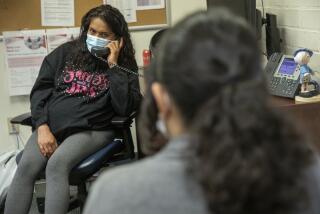California health insurance exchange struggling to enroll Latinos
For all its success enrolling tens of thousands in health insurance, California is struggling to translate Obamacare into Spanish.
The state’s enrollment so far among Latinos is anemic — even though they represent more than half of California’s 7 million uninsured residents. Only 5% of enrollees, or fewer than 4,500 people, in the first two months of enrollment are primarily Spanish speakers, new data show.
The dismal results have drawn sharp criticism from supporters of the healthcare law. They fault the Covered California exchange for strategic missteps, and they fear that missing out on this relatively young and healthy population could threaten the viability of the state exchange.
Without a large pool of people and enough younger policyholders to balance out older, sicker patients, rates could spiral up, and insurers may drop out of the state-run marketplace.
“It is unacceptable that Latinos are getting the least amount of access to the benefits offered by the Affordable Care Act,” said state Sen. Norma Torres (D-Pomona). “Covered California’s strategy for Latino enrollment has not proven itself to be effective. The success of this program and the affordability of health insurance in the future depends on Latinos signing up.”
In the months leading up to enrollment, exchange officials touted their plans to blanket the huge Latino market with advertising and station plenty of enrollment workers in their neighborhoods. But not all those plans have materialized.
Covered California officials and healthcare experts cite a number of factors for the poor showing. They say a shortage of enrollment counselors has affected Latinos more because so many prefer speaking with someone in person rather than signing up online or by phone. Another glaring problem is that 10 weeks into enrollment, the state exchange still doesn’t have a paper application in Spanish.
Those problems have made it that much harder to overcome the general mistrust some Latinos have toward government amid fears that sharing family information to get health coverage could expose undocumented relatives to deportation.
Covered California acknowledges it must do better at signing up Latinos, and representatives say they remain confident that people will show up by March 31, when open enrollment ends.
“We are doing everything within our power to increase the number of Latinos enrolling, and we know we will get there,” said Santiago Lucero, an exchange spokesman. “We know we can do better.”
The state’s current numbers may be undercounting Latino enrollment because many Latinos speak English primarily. Many applicants don’t give their ethnicity during the sign-up process, and state workers sometimes forget to record that information, so the exchange has focused on language as a measuring stick for now.
People who speak primarily Spanish account for 29% of California’s population, but they represent only 5% of exchange enrollment.
The shortfall among Spanish speakers is surprising given the significant amount of marketing targeted at Latinos statewide. In June, President Obama came to California to praise a partnership among the state exchange, the nonprofit California Endowment and major Spanish-language media outlets aimed at promoting enrollment.
The endowment alone is spending $25 million on advertising the benefits of the healthcare law, much of it in Spanish-language outlets such as Univision, Telemundo and La Opinion.
Covered California is spending millions on Latino-targeted advertising from its $80-million marketing budget. It has had a frequent presence on Spanish-language broadcasts, with officials answering viewer questions and participating in televised town halls.
During a Telemundo show that aired in Los Angeles last week, viewers were urged to call Covered California. But Lucero, the exchange spokesman, said the response overwhelmed its call centers that weekday morning.
Overall, the average wait time has grown to 36 minutes at the exchange, frustrating consumers.
“It wasn’t the best thing for us,” Lucero said. “We are adding more bilingual people at our call center.”
The exchange said it also hopes to have 4,000 enrollment counselors in place at the end of the month, up from 2,344 now.
More than half of the current enrollment workers speak Spanish, but delays in training and in completing background checks have hampered that outreach effort. The state’s original goal was to have 16,000 enrollment counselors.
“Demand is high, but systems aren’t meeting that demand,” said Daniel Zingale, a senior vice president at the California Endowment. “There are three points of entry: online, in person or over the phone, and there has been instability in all three.”
Katie Murphy, supervising attorney with Neighborhood Legal Services of Los Angeles County, said October and November were “lost months” with so few enrollment counselors available.
“Many of the certified enrollment counselors, the boots on the ground, have only been certified in the last couple of weeks,” Murphy said. “Groups where there’s a language issue or trust issues with the government will need the people in their communities to help them.”
Covered California’s website has been available in Spanish since enrollment launched in October. But patient advocates say that didn’t help some Latinos who don’t have online access or prefer reading over something on paper with their family.
The state exchange said a paper application in Spanish should be available next week. It attributed the long delay to getting government approvals and feedback from outside groups.
The lack of a paper application in Spanish is huge, said Sonya Vasquez, policy director for the Community Health Councils in Los Angeles. “There’s definitely a digital divide when it comes to going online and applying for things,” she said.
Covered California will need to attract plenty of Latinos if it hopes to reach its goal of enrolling 500,000 to 700,000 people in subsidized health insurance by March 31. Through Dec. 7, the state has enrolled 156,143 people in private health plans, and most of them are receiving federal subsidies.
The state estimates that 1.2 million Latinos should qualify for subsidies, which could help alleviate concerns about expensive premiums.
In California, Latinos are among the strongest supporters of the Affordable Care Act. A USC Dornsife/Los Angeles Times poll published last month showed that nearly two-thirds of Latinos in the state backed the law, compared with 50% approval among registered voters overall.
State Sen. Ed Hernandez (D-West Covina), chairman of the Senate Health Committee, said the exchange has a compelling sales pitch to Latinos.
“These enrollment numbers aren’t even close to where they need to be,” Hernandez said. “The state of California has to fix that.”
Twitter: @chadterhune
Twitter: @LATerynbrown
More to Read
Inside the business of entertainment
The Wide Shot brings you news, analysis and insights on everything from streaming wars to production — and what it all means for the future.
You may occasionally receive promotional content from the Los Angeles Times.












